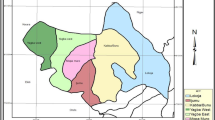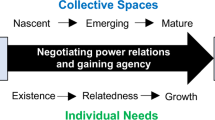Abstract
This article discusses the hitherto little-studied question of women workers’ empowerment through access to labor rights in the east African export horticultural sector. It is based on the work carried out by Women Working Worldwide and its east African partners, drawing on primary research on cut-flower farms in Ethiopia, Tanzania, and Uganda. The focus in discussions of women’s empowerment has tended to be on individual actors rather than collective strategies. We argue that strategies such as action research, education, organization and advocacy focusing on labor rights are effective in gendered empowerment and can bring positive change to women’s working lives on African farms, and beyond.
Similar content being viewed by others
References
Action Aid et al. (2012). What works for women, background paper. London (unpublished).
Amoding, F. (2011). Email correspondence with WWW. 25 July.
Banik, D. (2008). Rights, legal empowerment and poverty: An overview of the issues. In D. Banik (Ed.), Rights and legal empowerment in eradicating poverty (pp. 11–30). London: Ashgate.
Barrientos, S. (2001). Gender, flexibility and global value chains. IDS Bulletin, 32(3), 83–93.
Barrientos, S. (2007). Female employment in agriculture: Global challenges and global responses. London: Commonwealth Secretariat, www.pathwaysofempowerment.org/CommSec_Barrientos.pdf. Accessed April 15 2012.
Comic Relief. (2012). Feedback on the evaluation report. Email correspondence with WWW. 16 January.
Cornwall, A., & Jenkes, R. (1995). What is participative research? Social Science and Medicine, 41(12), 1667–1676.
Dickens, L. (2000). Collective bargaining and the promotion of gender equality at work. Transfer: European Review of Labor and Research, 6(2), 193–208.
Elson, D. (1995). Overcoming male bias. In D. Elson (Ed.), Male bias in the development process (pp. 191–210). Manchester: Manchester University Press.
Forum for Environment (FfE). (2009). 6 month report, September, 2008–February 2009, Addis Ababa (unpublished).
Hale, A. (1996). The deregulated global economy: Women workers and strategies of resistance. In C. Sweetman (Ed.), Women, employment and exclusion (pp. 8–15). Oxford: Oxfam.
Kabeer, N. (1994). Reversed realities: Gender hierarchies in development thought. London: Verso.
Kabeer, N. (1999). Resources, agency, achievements: Reflections on the measurement of women’s empowerment. Development and Change, 30(3), 435–464.
Khader, S. (2011). Adaptive preferences and women’s empowerment. Oxford: Oxford University Press.
Kumar, K. (1995). From post-industrial to post-modern society. Oxford: Blackwell.
Labuschagne, L. (2008). Flower farming: Kenyan floriculture leads the way. Pesticides, 82(12), 6–7.
Marix Evans, L. (2011). Evaluation report—Ethiopia and Tanzania. Manchester (unpublished).
Mather, C., et al. (2011). Learning together—An educational manual for workers on flower and vegetable export farms of East/South Africa. Manchester: WWW.
Mayoux, L. (2002). Women’s empowerment or feminisation of debt? Towards a new agenda in African microfinance. London: One World Action.
Mosedale, S. (2005). Assessing women’s empowerment: Towards a conceptual framework. Journal of International Development, 17(2), 243–257.
Mosha, P. (2011). Email correspondence with WWW, 20 July.
Munro, A. (1999). Women, work and trade unions. London: Mansell.
National Federation of Farm Plantation Fishery and Agro Industry Trade Unions (NFFPFATU) (2010). Draft action research report, Addis Ababa (unpublished).
Odete, E. (2011). Evaluation report, Uganda. Manchester (unpublished).
Parpart, J., Rai, S., & Staudt, K. (Eds.). (2003). Rethinking empowerment: Gender and development in a global/local world. London: Routledge.
Pearson, R. (2007). Reassessing paid work and women’s empowerment: Lessons from the global economy. In A. Cornwall, E. Harrison, & A. Whitehead (Eds.), Feminisms in development (pp. 201–213). London: Zed Books.
Phillips, A. (1980). Sex and skill: Notes towards a feminist economics. Feminist Review, 6, 79–88.
Randall, V. (1996). Gender and power: Women engage the State. In V. Randall, G. Waylen, & A. Whitehead (Eds.), Gender, politics and the state (pp. 185–205). London: Routledge.
Reason, P., & Bradbury, H. (2001). Introduction: Inquiry and participation in a world worthy of human aspiration. In P. Reason & H. Bradbury (Eds.), The SAGE handbook of action research (1st Edition ed., pp. 8–14). London: Sage.
Robinson, M. (2002). The microfinance revolution: Lessons from Indonesia. Washington, DC: World Bank.
Rogaly, B. (1996). Microfinance evangelism, “destitute women” and the hard selling of a new anti-poverty formula. Development in Practice, 6(2), 100–112.
Rowlands, J. (1997). Questioning empowerment: Working with women in Honduras. Oxford: Oxfam.
Selwyn, B. (2009). Trade unions and women’s empowerment in Northeast Brazil. Gender and Development, 17(2), 189–201.
Sen, G., & Grown, C. (1988). Development, crises and alternative visions. London: Earthscan.
Stephen, L. (1993). Challenging gender inequality: Grassroots organizing among women rural workers in Brazil and Chile. Critique of Anthropology, 13(1), 33–55.
Stromqvist, N. (2002). Education as a means of empowering women. In J. Parpart, S. Rai, & K. Staudt (Eds.), Rethinking empowerment: Gender and development in a global/local world (pp. 22–37). London: Routledge.
Tanzania Plantation and Agricultural Workers Union (TPAWU) (2005). Promoting women’s rights in African horticulture, progress report, February–July 2005. Dar-es-Salaam (unpublished).
Townsend, J., et al. (1999). Women and power: Fighting patriarchies and poverty. London: Zed Books.
TPAWU. (2006). Case studies from Tanzania. Dar-es-Salaam: (unpublished).
TPAWU (2007). Report on the situation and needs of horticulture workers in the international supply chain—the case of Tanzania. Dar-es-Salaam (unpublished).
TPAWU. (2009). TPAWU 6 month report, October 2008–March 2009. Dar-es-Salaam: (unpublished).
TPAWU. (2011). Action research report: Factors affecting labor conditions in the horticulture industry in Tanzania http://www.women-ww.org/documents/Research-Booklet-TPAWU.pdf. Accessed 15 April 2012.
Uganda Workers’ Education Association (UWEA). (2007). Case studies from Uganda. Kampala (unpublished).
UWEA. (2009). UWEA 6 month report, October 2008–March 2009. Kampala: (unpublished).
UWEA. (2010). UWEA 6 month report, October 2009–March 2010. Kampala: (unpublished).
UWEA. (2011a). UWEA 6 month report, October 2010–March 2011. Kampala: (unpublished).
UWEA. (2011b). Developing strategies for change for women workers in African Horticulture, the case of Uganda http://www.women-ww.org/documents/UWEA-final-research-report.pdf. Accessed April 15, 2012.
UWEA. (2011c). “We are dying”. Impacts of pesticides on workers on. Ugandan horticultural farms. http://www.fian.at/assets/Report-on-pesticide-impacts-Uganda-2011-final.pdf. Accessed April 15 2012.
Walby, S. (1997). Gender transformations. London: Routledge.
Wills, J., & Hurley, J. (2005). Action research: Tracing the threads of labor. In A. Hale & J. Wills (Eds.), Threads of labor, garment industry supply chains from the workers’ perspective (pp. 69–94). Oxford: Blackwel.
Women Working Worldwide (WWW). (2007). Promoting women workers’ rights in African horticulture http://www.women-ww.org/documents/www_research_overview_final.pdf. Accessed 15 April 2012.
Acknowledgments
Bénédicte Brahic and Susie Jacobs would like to thank Melanie Plank for her kind help in carrying out the literature search.
Author information
Authors and Affiliations
Corresponding author
Rights and permissions
About this article
Cite this article
Brahic, B., Jacobs, S. Empowering Women: A Labor Rights-Based Approach: Case Studies from East African Horticultural Farms. J Agric Environ Ethics 26, 601–619 (2013). https://doi.org/10.1007/s10806-012-9424-9
Accepted:
Published:
Issue Date:
DOI: https://doi.org/10.1007/s10806-012-9424-9




